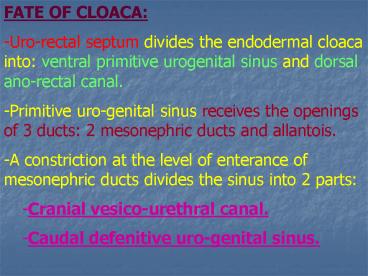DEVELOPMENT OF URINARY BLADDER - PowerPoint PPT Presentation
1 / 13
Title:
DEVELOPMENT OF URINARY BLADDER
Description:
FATE OF CLOACA: Uro-rectal septum divides the endodermal cloaca into: ventral primitive urogenital sinus and dorsal ano-rectal canal. Primitive uro-genital sinus ... – PowerPoint PPT presentation
Number of Views:830
Avg rating:3.0/5.0
Title: DEVELOPMENT OF URINARY BLADDER
1
- FATE OF CLOACA
- Uro-rectal septum divides the endodermal cloaca
into ventral primitive urogenital sinus and
dorsal ano-rectal canal. - Primitive uro-genital sinus receives the openings
of 3 ducts 2 mesonephric ducts and allantois. - A constriction at the level of enterance of
mesonephric ducts divides the sinus into 2 parts - Cranial vesico-urethral canal.
- Caudal defenitive uro-genital sinus.
2
(No Transcript)
3
(No Transcript)
4
(No Transcript)
5
(No Transcript)
6
(No Transcript)
7
(No Transcript)
8
DEVELOPMENT OF URINARY BLADDER
- It develops from 3 parts
- Vesico-urethral canal (endodermal) forms most of
the bladder. - Proximal part of allantois (endodermal) forms
apex of the bladder, rest of allantois is called
urachus. Later the urachus becomes obliterated to
be median umbilical ligament. - Caudal parts of both mesonephric ducts forms the
trigone of the bladder.
9
CONGENITAL ANAMALIES
- Ectopia Vesicae due to failure of formation of
anterior abdominal wall and anterior wall of
urinary bladder. - Urachal Fistula due to failure of obliteration
of urachus. - Urachal Cyst failure of obliteration of
localized part of urachus. - Urachal Sinus failure of obliteration of distal
part of urachus.
10
DEVELOPMENT OF MALE AND FEMALE URETHERA
- Female Urethra is developed mostly from
vesico-urethral canal (cranial part of primitive
uro-genital sinus). - Male Urethera Is composed of 3 parts
- Prostatic urethera is developed from
vesico-uretheral canal and absorbed mesonephric
duct (upper 1/2) as well as pelvic part of
defenitive uro-genital sinus (lower 1/2). 15 buds
from the wall of urethera form the prostate gland
by 12th week. - Membranous urethera from pelvic part of
defenitive uro-genital sinus. - Penile urethera most of penile urethera is
developed from phallic part of defenitive
uro-genital sinus by the formation of uretheral
plate then canal. Part of penile urethera in
galns penis is developed from surface ectoderm.
Two buds from proximal part of penile urethera
will form bulbo-uretheral glands.
11
Fate of primitive urogenital sinus A-
Vesicouretheral canal -Forms most of urinary
bladder in both sex. -Female urethera. -Upper ½
of prostatic urethera. N.B. Absorbed mesonephric
ducts forms -Trigone of the bladder. -Back of
femal urethera. -Back of upper ½ of prostatic
urethera.
12
B- Pelvic part of defenitive urogenital
sinus Forms lower ½ of prostatic urethera and
membranous urethera. C- Phalic part of definitive
urogenital sinus - Forms uretheral plate which
is transformed into uretheral canal that form the
penile urethera except in glans penis which is
developed from cord of ectodermal cells which
becomes canalized and communicates with rest of
urethera.
13
CONGENITAL ANOMALIES OF URETHERA
- Epispadius when urethera opens into the upper
surface of penis. - Hypospadius when urethera opens into lower
surface of penis.































